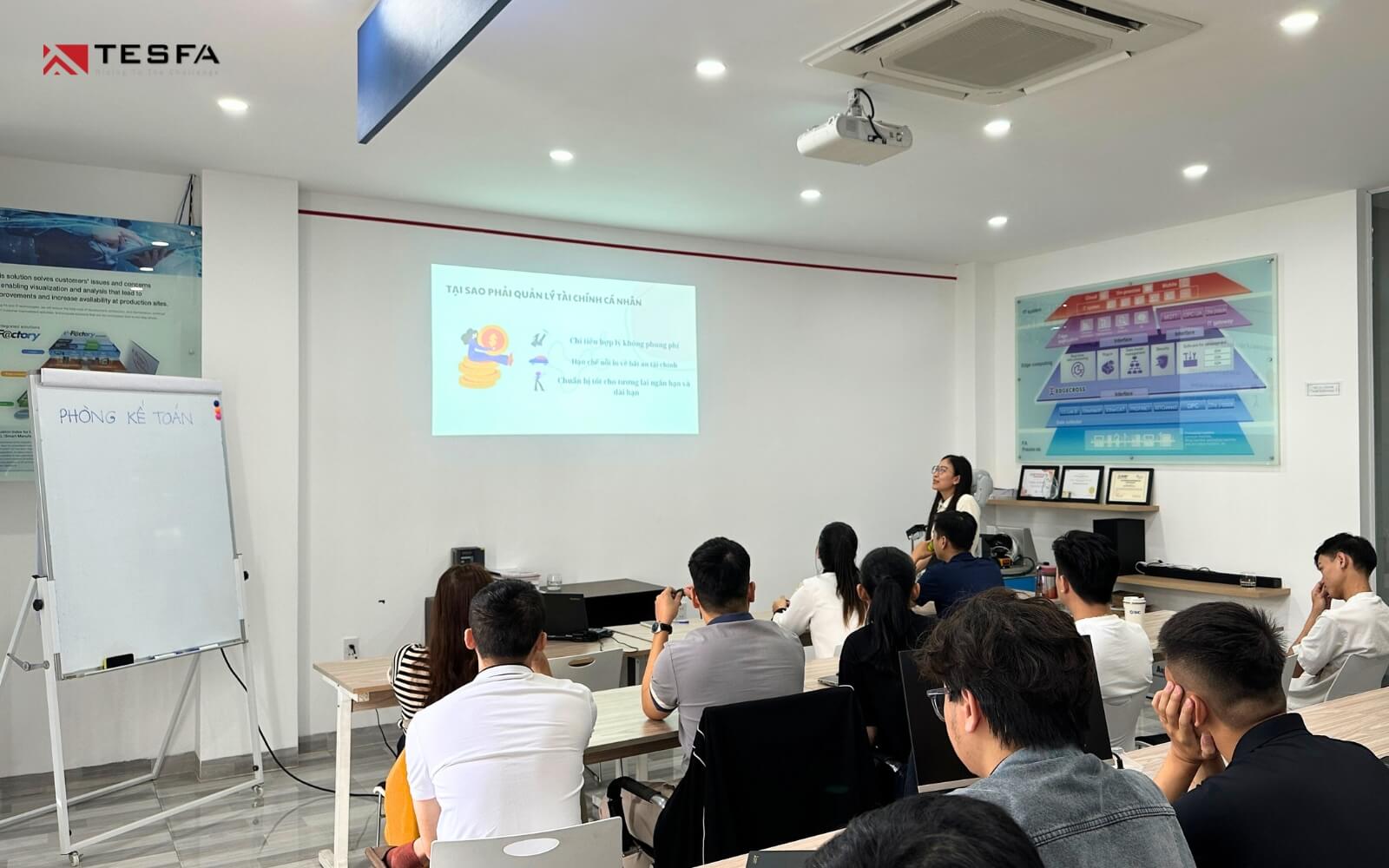TESFA recently organized an internal sharing session on the topic of “Personal Finance Management.” This special session was led by Ms. Kim Hanh – not only a talented accountant but also one of TESFA’s most veteran staff members. With extensive experience and the ability to handle a myriad of complex financial situations, Ms. Kim Hanh brought practical and valuable knowledge that no book can convey.

The entire staff of TESFA attended the sharing session, and everyone found the session with this special topic unmissable. From the clear presentation to the final quiz game, the event ran smoothly and provided a lot of useful information, especially as these are essential soft skills for anyone. Below are some of the highlights of the sharing session recorded by TESFA; let’s take a look back.
What is personal finance?
The sharing session began with a definition of personal finance. Ms. Kim Hanh explained that it is the process of managing personal money, including income, expenses, savings, and investments. She emphasized that personal finance plays a role as a tool to help each person control cash flow and orient financial direction effectively.
Why manage personal finance?
After clarifying the concept, Ms. Kim Hanh moved on to present the reasons for the necessity of managing personal finance, focusing on five main aspects.
- First, financial management helps take control of cash flow, allowing individuals to clearly understand their income and expenses, and avoid shortages at the end of the month.
- Second, it supports the achievement of personal financial goals, such as buying a house, purchasing a car, or carrying out long-term plans.
- Third, effective management can increase asset volume through proper saving or investing.
- Fourth, it creates favorable conditions for growth opportunities, such as investing in education or personal projects when finances are stable.
- Lastly, it provides preparedness for unexpected incidents, with an emergency fund serving as a safety net in times of hardship, such as job loss or sudden medical expenses.

These benefits are presented logically along with real-life examples, helping employees clearly understand the importance of the topic.
Principles of Personal Financial Management
To make the implementation more practical, Ms. Kim Hanh went on to introduce six fundamental principles of personal financial management.
- The first principle is to identify your budget sources, requiring each individual to clearly understand their total income from sources such as salary or side jobs in order to plan appropriately.
- Second, always review your spending to control unnecessary expenses and make adjustments when needed.
- Third, setting clear financial goals and roadmaps helps break down larger plans into achievable steps — such as saving a specific amount within a certain timeframe.
- Fourth, avoid spending more than 10% of your income to maintain financial balance.
- Fifth, escape the debt cycle by prioritizing debt repayment and limiting new borrowing.
- Lastly, saving 10–15% of your monthly income is recommended as a way to build a solid long-term financial foundation.
These principles are explained in detail, accompanied by real-life examples to help everyone easily visualize and apply them.

Common Mistakes in Personal Financial Management
After presenting the principles, Ms. Kim Hạnh moved on to analyze the common mistakes in managing personal finances.
- First, lacking a plan or goal leads to inefficient use of money.
- Second, not fully understanding debt can result in accumulating high interest and struggling with repayments.
- Third, excessive, unnecessary, and emotional spending often drains financial resources without delivering long-term value.
- Fourth, impatience and overly high expectations can cause people to abandon their plans when results don’t appear immediately.
- Lastly, failing to build an emergency fund leaves individuals vulnerable when facing unexpected situations.
These insights were delivered objectively, helping employees reflect on their own financial management practices.

Which tools should be used for personal financial management?
To support the application of the previously discussed principles, Ms. Kim Hạnh moved on to suggest several financial management tools. The options included apps such as Money Lover, Spendee, or Excel spreadsheets. For those who prefer a more traditional approach, a handwritten notebook can also be an effective solution. She emphasized that the most suitable tool depends on each individual’s habits and needs. Some employees even began exploring these apps during the session, showing a genuine interest in practical application.

Effective Ways to Manage Personal Finances
Following the discussion on tools, Ms. Kim Hạnh introduced the 50/30/20 rule as a simple and effective method for managing personal finances. According to this method, income is divided into three categories:
50% – S Account (Survival): Allocated for essential living expenses such as housing, food, and transportation.
20% – S Account (Savings): Reserved for savings, investments, or an emergency fund to ensure future financial security.
- 30% – C Account (Comfort): Used for entertainment, shopping, or leisure activities to maintain quality of life.

Quiz game
To conclude the main content, the session transitioned into a multiple-choice quiz game designed to reinforce the knowledge shared. This activity was not only entertaining but also encouraged employees to reflect on their personal financial habits.

Conclusion
At the end of the session, Ms. Kim Hạnh left the audience with a message: “Personal financial management is a simple process if you start with small changes.”
TESFA employees expressed their agreement with a round of applause, closing the event on a positive note. From an observer’s perspective, the session was well-organized, delivered practical knowledge, and created opportunities for employees to apply what they learned in real life. TESFA successfully hosted a meaningful internal activity that not only raised financial awareness but also strengthened team bonding.









